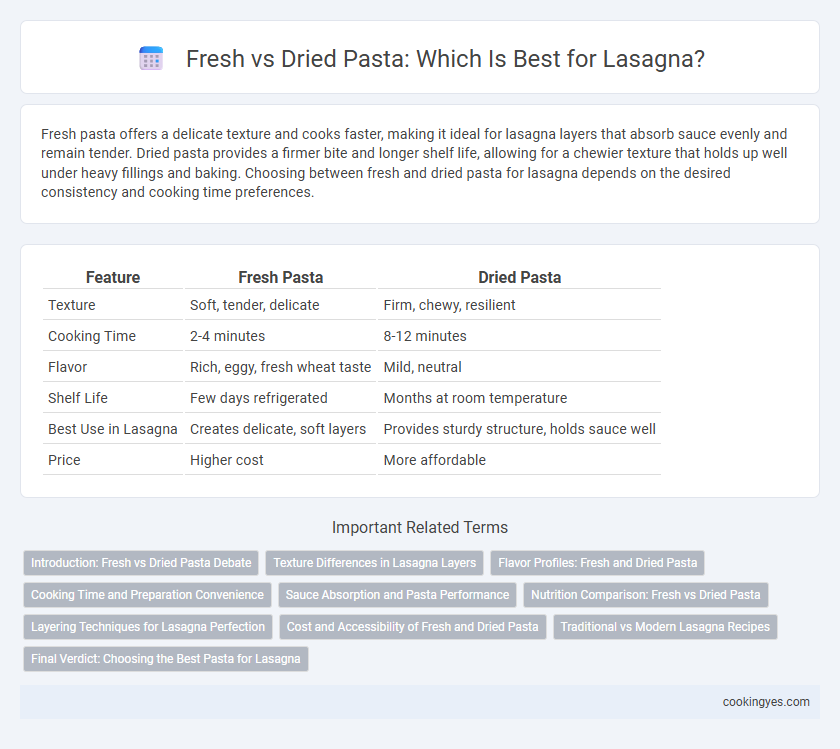Fresh pasta offers a delicate texture and cooks faster, making it ideal for lasagna layers that absorb sauce evenly and remain tender. Dried pasta provides a firmer bite and longer shelf life, allowing for a chewier texture that holds up well under heavy fillings and baking. Choosing between fresh and dried pasta for lasagna depends on the desired consistency and cooking time preferences.
Table of Comparison
| Feature | Fresh Pasta | Dried Pasta |
|---|---|---|
| Texture | Soft, tender, delicate | Firm, chewy, resilient |
| Cooking Time | 2-4 minutes | 8-12 minutes |
| Flavor | Rich, eggy, fresh wheat taste | Mild, neutral |
| Shelf Life | Few days refrigerated | Months at room temperature |
| Best Use in Lasagna | Creates delicate, soft layers | Provides sturdy structure, holds sauce well |
| Price | Higher cost | More affordable |
Introduction: Fresh vs Dried Pasta Debate
Fresh pasta offers a tender texture and absorbs sauces more readily, enhancing the layered richness of lasagna. Dried pasta boasts a firmer bite and longer shelf life, making it a convenient choice for hearty, structured dishes. The decision between fresh and dried pasta significantly impacts lasagna's flavor, texture, and overall cooking time.
Texture Differences in Lasagna Layers
Fresh pasta in lasagna offers a tender, delicate texture that absorbs sauces well, creating smooth, cohesive layers. Dried pasta provides a firmer bite and distinct structural integrity, which helps maintain defined layers throughout baking. The choice between fresh and dried pasta significantly impacts the mouthfeel and layering experience in a lasagna dish.
Flavor Profiles: Fresh and Dried Pasta
Fresh pasta for lasagna offers a delicate, tender texture with a richer, egg-infused flavor that absorbs sauces beautifully, enhancing the overall dish complexity. Dried pasta provides a firmer bite and a more neutral taste, allowing robust, hearty sauces to shine without competing with the pasta itself. Choosing between fresh and dried pasta depends on desired flavor intensity and texture preference in a lasagna recipe.
Cooking Time and Preparation Convenience
Fresh pasta requires significantly less cooking time, usually around 2 to 4 minutes, making it ideal for quick preparation of lasagna with a tender texture. Dried pasta demands longer cooking, approximately 10 to 12 minutes, but offers the convenience of longer shelf life and ease of storage. Choosing between fresh and dried pasta depends on balancing the need for fast cooking against pantry convenience in lasagna preparation.
Sauce Absorption and Pasta Performance
Fresh pasta for lasagna offers superior sauce absorption due to its porous texture, resulting in a more flavorful and cohesive dish. Dried pasta maintains structural integrity better during baking, preventing over-softening and preserving distinct layers. Choosing fresh pasta enhances sauce infusion, while dried pasta provides consistent performance in oven settings.
Nutrition Comparison: Fresh vs Dried Pasta
Fresh pasta contains higher moisture content and generally offers slightly more protein and fewer calories per serving compared to dried pasta. Dried pasta has a longer shelf life and typically provides more fiber and complex carbohydrates, supporting sustained energy release. Both types contain similar essential nutrients, but fresh pasta may retain more vitamins due to less processing.
Layering Techniques for Lasagna Perfection
Fresh pasta offers a pliable texture ideal for smooth layering in lasagna, allowing sheets to meld seamlessly with cheese and sauce. Dried pasta requires precooking or soaking to prevent uneven cooking and brittle layers, necessitating precise timing for perfect structure. Choosing fresh pasta enhances the layering technique, resulting in a tender, cohesive lasagna with balanced moisture and flavor distribution.
Cost and Accessibility of Fresh and Dried Pasta
Dried pasta is generally more cost-effective and widely accessible than fresh pasta, making it the preferred choice for budget-conscious lasagna preparations. Fresh pasta often comes at a higher price point and is typically found only in specialty stores or fresh pasta sections, limiting accessibility. The longer shelf life of dried pasta also contributes to its affordability and convenience for everyday cooking.
Traditional vs Modern Lasagna Recipes
Fresh pasta offers a tender texture and absorbs sauces better in traditional lasagna recipes, delivering authentic Italian flavor. Dried pasta provides convenience and a firmer bite, favored in modern lasagna variations that layer intense, hearty fillings. Both types influence cooking time and sauce integration, impacting the final dish's consistency and taste.
Final Verdict: Choosing the Best Pasta for Lasagna
Fresh pasta offers a tender texture and quicker cooking time, making it ideal for delicate, layered lasagna recipes where moisture balance is crucial. Dried pasta provides a firmer bite and longer shelf life, perfect for heartier, more robust sauces that benefit from sustained cooking. Selecting between fresh and dried pasta depends on desired texture and cooking method, with fresh pasta favored for soft, silky layers and dried pasta preferred for firmer, more structured lasagna.
Fresh pasta vs Dried pasta for lasagna Infographic

 cookingyes.com
cookingyes.com